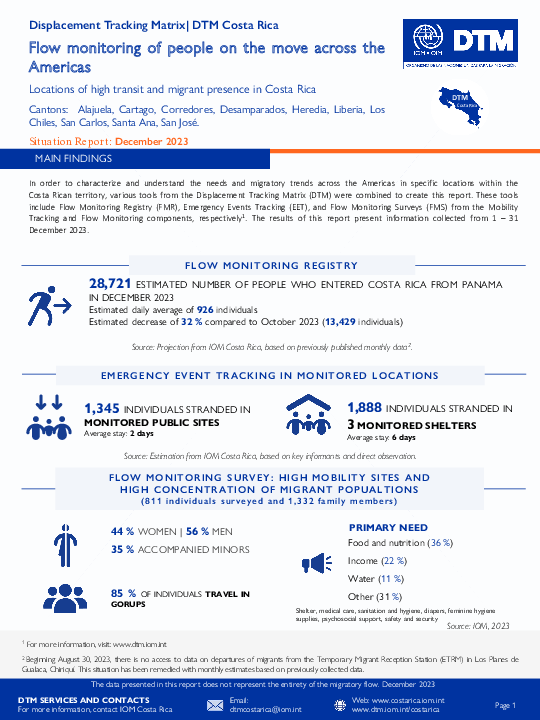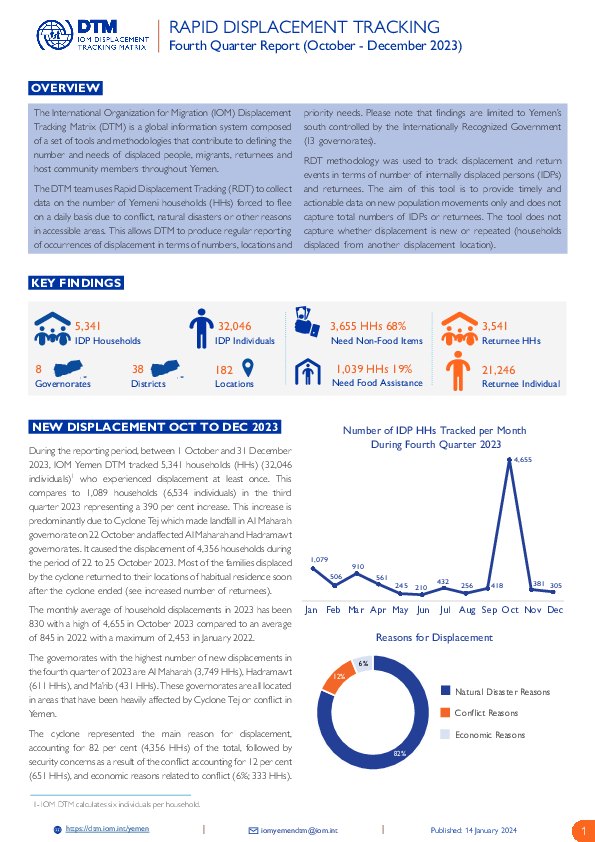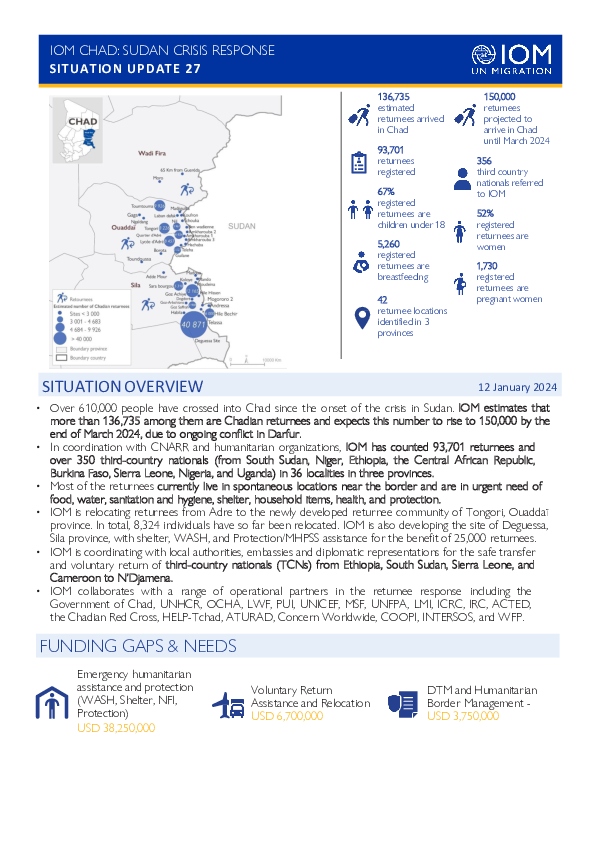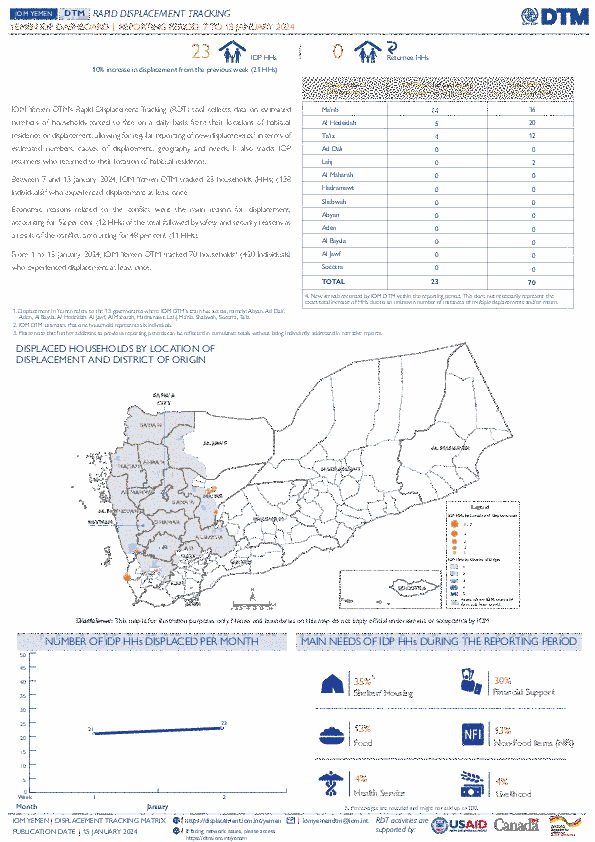-
Countries
-
Data and Analysis
-
Special Focus
-
Crisis Responses
Event Tracking

Contact
dtmhaiti@iom.int
Language
English
Location
Haiti
Period Covered
Jan 15 2024
Jan 18 2024
Activity
- Mobility Tracking
- Event Tracking
The objective of the Emergency Tracking Tool (ETT) is to collect information on large and sudden population movements as well as security and climatic emergencies. Information is collected through phone interviews with key informants and direct observation.
This information was collected following ongoing armed attacks in the neighborhoods of Solino and its surroundings as well as in the Gabelliste neighborhood, all located in the municipality of Port-au-Prince. Attacks in Solino began on 14 January 2024 and in Gabelliste on 2 January. At the time of writing this report, they are still ongoing and populations’ displacements continue. Updates will be published by DTM according to the evolution of displacement. For the moment a total of 1,079 people have already been displaced following these attacks, including 761 following the attacks in Solino and its surroundings and 318 following those in Gabelliste. The majority of displaced populations (60%) took refuge in sites (8 in total).
Contact
dtmuganda@iom.int
Location
Uganda
Activity
- Event Tracking
Period Covered
Oct 01 2023 -Nov 14 2023
In September 2023, the Prime Minister Office’s, in conjunction with Ministry of Water & Environment and Uganda National Meteorological Authority published an alert on the potential impacts of floods related to el niño during the September – December rainy season. To monitor those, DTM Uganda, in collaboration with District Disaster Management Committees and Ministries Departs & Agencie activated its Emergency Event Tracking. In fact, between 1 October and 14 November 2023, over 79,000 individuals have been affected by el niño-related floods and other associated events related to heavy rains, such as landslides, mudslides, and traffic road accidents. Widespread heavy rains have caused significant damage to roads, bridges and properties across various regions, disrupting socio-economic activities and access to education, markets and health facilities; while above 2,600 acres of cultivable land have been destroyed exposing affected communities to food insecurity, especially to the almost 23,600 IDPs.
A more detailed version of this dataset is available, to get access kindly click on the 'Request Access' button
Population Groups
IDPs
Residents
Survey Methodology
Unit of Analysis Or Observation
Admin Area 2
Admin Area 3
Admin Area 4
Community
Type of Survey or Assessment
Key Informant
Keywords
Geographical Scope Full Coverage
Administrative boundaries with available data
The current dataset covers the following administrative boundaries

Contact
DTMMozambique@iom.int
Language
English
Location
Mozambique
Period Covered
Dec 26 2023
Jan 17 2024
Activity
- Mobility Tracking
- Event Tracking
Between 26 December 2023 and 17 January 2024, a series of attacks in villages across Macomia, and Muidumbe triggered the displacement 5,343. Of the total individuals displaced, 411 families with 1,407 individuals have taken refuge in displacement centers of Macomia (Changane, Xinavane, Nanga A and Nanga B), 220 families with 740 individuals have taken refuge in displacement centers of Mueda (Imbuhu, Mpeme) and 78 families with 260 individuals have taken refuge in displacement centers of Muidumbe (Miteda and Lutete).

Contact
DTM Cameroon, DTMCameroun@iom.int
Language
French
Location
Cameroon
Period Covered
Jan 09 2024
Jan 15 2024
Activity
- Mobility Tracking
- Event Tracking
Le suivi des situations d’urgence (en anglais, Emergency Tracking Tool, ETT) est une des composantes de la Matrice de suivi des déplacements (en anglais, Displacement Tracking Matrix, DTM) déployée par l’Organisation Internationale pour les Migrations (OIM). Il a pour objectif de rassembler des informations sur les mouvements significatifs et soudains de populations, ainsi que sur des urgences sécuritaires et climatiques. Les données ont été collectées par observation directe et par des entretiens téléphoniques, auprès de six informateurs clés, principalement des autorités locales, des organisations non-gouvernementales (ONG), des organisations de la société civile (OSC) et des représentants des populations dans les lieux affectés.
Ce tableau de bord présente des informations sur le déplacement de populations des localités de Tourou, Loctcha, Batawaya, Ldamang, Ldubam (arrondissement de Mokolo) et Godzongodzong (arrondissement du Mayo-Moskota) vers les localités de Mikilik, Sirak-Gorai,Ouro-Tada (Sekande), Ldamang (kedalai), Ldubam, Djimeta, Zimangayak, Fada, Ldamtsaï, Mendejé et Zamalva, arrondissement de Mokolo, département du Mayo -Tsanaga.
Contact
DTM Yemen, iomyemendtm@iom.int
Location
Yemen
Activity
- Mobility Tracking
- Event Tracking
Period Covered
Oct 01 2023 -Dec 31 2023
From 1 January to 31 December 2023, IOM Yemen DTM tracked 9,958 households (HH) (59,748 Individuals) who experienced displacement at least once.
Between 1 October and 31 December 2023, IOM Yemen DTM tracked 5,341 households (32,046 individuals) displaced at least once. The majority of people moved into/within the following governorates and districts:
- Al Maharah (3,749 HHs) – Haswin (1815 HHs), Al Ghaydhah (1,123 HHs), Qishn (310 HHs) districts. Most displacements in the governorate originated from Marib and Al Hodeidah.
- Hadramawt (611 HHs) – Ar Raydah wa Qussayar (597 HHs), Ad Dis (10 HHs), Ash Shihr (4 HHs) districts. Most displacements in the governorate originated from Taiz and Al Hodeidah.
- Ma’rib (431 HHs) – Marib City (217 HHs), Marib (152 HHs), Harib (60 HHs) districts. All displacements in the governorate were internal.
The majority of people moved from the following governorates and districts:
- Al Maharah (3,750 HHs) – Al Ghaydhah (2,773 HHs), Qishn (310 HHs), Haswin (216 HHs) districts.
- Hadramawt (612 HHs) – Ar Raydah wa Qussayar (607 HHs), Sayun (2 HHs), Al Abr (1 HHs) districts.
- Al Hodeidah (347 HHs) – At Tuhayta (161 HHs), Hays (40 HHs), Al Jarrahi (31 HHs) districts.
Population Groups
Survey Methodology
Unit of Analysis Or Observation
Type of Survey or Assessment
Keywords
Geographical Scope
Administrative boundaries with available data
The current dataset covers the following administrative boundaries

Contact
DTMCostaRica@iom.int
Language
English
Location
Costa Rica
Period Covered
Dec 01 2023
Dec 31 2023
Activity
- Flow Monitoring
- Mobility Tracking
- Event Tracking
Cantons: Liberia, Los Chiles, San Carlos, Heredia, Alajuela, Cartago, San José y Corredores.
Costa Rica, like the other countries in the Central American region, has been characterized as a migratory corridor for people who transit by land from the south to the north of America and whose destination is the countries in the north of the continent. This flow on the move through the Americas is mainly made up of people from the Bolivarian Republic of Venezuela, Cuba, Haiti, Ecuador, as well as people from other countries in South America, Africa and Asia.
According to estimations from IOM Costa Rica, during December 28,721 people entered the country, an approximate average of 926 people per day and estimating a decrease of 32% compared to November 2023. In addition, 1,888 people stranded in the monitored shelters were identified and 1,345 people stranded in the public places visited.

Contact
DTM Yemen, iomyemendtm@iom.int
Language
English
Location
Yemen
Period Covered
Oct 01 2023
Dec 31 2023
Activity
- Mobility Tracking
- Event Tracking
During the reporting period, between 1 October and 31 December 2023, IOM Yemen DTM tracked 5,341 households (HHs) (32,046 individuals)1 who experienced displacement at least once. This compares to 1,089 households (6,534 individuals) in the third quarter 2023 representing a 390 per cent increase. This increase is predominantly due to Cyclone Tej which made landfall in Al Maharah governorate on 22 October and affected Al Maharah and Hadramawt governorates. It caused the displacement of 4,356 households during the period of 22 to 25 October 2023.
Most of the families displaced by the cyclone returned to their locations of habitual residence soon after the cyclone ended (see increased number of returnees).
The monthly average of household displacements in 2023 has been 830 with a high of 4,655 in October 2023 compared to an average of 845 in 2022 with a maximum of 2,453 in January 2022.
The governorates with the highest number of new displacements in the fourth quarter of 2023 are Al Maharah (3,749 HHs), Hadramawt (611 HHs), and Ma’rib (431 HHs). These governorates are all located in areas that have been heavily affected by Cyclone Tej or conflict in Yemen.
The cyclone represented the main reason for displacement, accounting for 82 per cent (4,356 HHs) of the total, followed by security concerns as a result of the conflict accounting for 12 per cent (651 HHs), and economic reasons related to conflict (6%; 333 HHs).

Contact
DTM Chad, dtmtchad@iom.int
Language
English
Location
Chad
Period Covered
Jan 12 2024
Jan 12 2024
Activity
- Mobility Tracking
- Event Tracking
Over 610,000 people have crossed into Chad since the onset of the crisis in Sudan. IOM estimates that more than 136,735 among them are Chadian returnees and expects this number to rise to 150,000 by the end of March 2024, due to ongoing conflict in Darfur.
• In coordination with CNARR and humanitarian organizations, IOM has counted 93,701 returnees and over 350 third-country nationals (from South Sudan, Niger, Ethiopia, the Central African Republic, Burkina Faso, Sierra Leone, Nigeria, and Uganda) in 36 localities in three provinces.
• Most of the returnees currently live in spontaneous locations near the border and are in urgent need of food, water, sanitation and hygiene, shelter, household items, health, and protection.
• IOM is relocating returnees from Adre to the newly developed returnee community of Tongori, Ouaddaï province. In total, 8,324 individuals have so far been relocated. IOM is also developing the site of Deguessa, Sila province, with shelter, WASH, and Protection/MHPSS assistance for the benefit of 25,000 returnees.
• IOM is coordinating with local authorities, embassies and diplomatic representations for the safe transfer and voluntary return of third-country nationals (TCNs) from Ethiopia, South Sudan, Sierra Leone, and Cameroon to N’Djamena.
• IOM collaborates with a range of operational partners in the returnee response including the Government of Chad, UNHCR, OCHA, LWF, PUI, UNICEF, MSF, UNFPA, LMI, ICRC, IRC, ACTED, the Chadian Red Cross, HELP-Tchad, ATURAD, Concern Worldwide, COOPI, INTERSOS, and WFP.

Contact
DTM Yemen, iomyemendtm@iom.int
Language
English
Location
Yemen
Period Covered
Jan 07 2024
Jan 13 2024
Activity
- Mobility Tracking
- Event Tracking
IOM Yemen DTM’s Rapid Displacement Tracking (RDT) tool collects data on estimated numbers of households forced to flee on a daily basis from their locations of origin or displacement, allowing for regular reporting of new displacements in terms of estimated numbers, geography, and needs. It also tracks returnees who returned to their location of origin.
From 1 January to 14 January 2024, IOM Yemen DTM tracked 70 households (HH) (420 Individuals) who experienced displacement at least once.
Between 7 and 14 January 2024, IOM Yemen DTM tracked 23 households (138 individuals) displaced at least once. The majority of people moved into/within the following governorates and districts:
- Ma’rib (14 HHs) – Marib City (7 HHs), Harib (4 HHs), Marib (3 HHs) districts. Most displacements in the governorate originated from Marib and Al Hodeidah.
- Al Hodeidah (5 HHs) – Hays (3 HHs), Al Khukhah (2 HHs) districts. Most displacements in the governorate originated from Taiz and Al Hodeidah.
- Ta’iz (4 HHs) – Al Makha (3 HHs), As Silw (1 HH) districts. All displacements in the governorate were internal.
The majority of people moved from the following governorates and districts:
- Ta’iz (9 HHs) – Al Mudhaffar (3 HHs), Maqbanah (3 HHs), Jabal Habashi (1 HH) districts.
- Al Jawf (4 HHs) – Al Hazm (4 HHs) district.
- Al Hodeidah (3 HHs) – Bajil (1 HH), Al Marawiah (1 HH), At Tuhayta (1 HH) districts.
IOM identified 28 households displaced in the previous reporting period, which covered 31 December - 06 January 2024, in the governorates of Ma’rib (13 HHs), Al Hodiedah (13 HHs), Lahj (2 HHs). These figures have been added to the cumulative displacement total recorded since the beginning of the year.
Contact
DTM Yemen, iomyemendtm@iom.int
Location
Yemen
Activity
- Mobility Tracking
- Event Tracking
Period Covered
Jan 07 2024 -Jan 13 2024
From 1 January to 13 January 2024, IOM Yemen DTM tracked 70 households (HH) (420 Individuals) who experienced displacement at least once.
Between 7 and 13 January 2024, IOM Yemen DTM tracked 23 households (138 individuals) displaced at least once. The majority of people moved into/within the following governorates and districts:
- Ma’rib (14 HHs) – Marib City (7 HHs), Harib (4 HHs), Marib (3 HHs) districts. Most displacements in the governorate originated from Marib and Al Hodeidah.
- Al Hodeidah (5 HHs) – Hays (3 HHs), Al Khukhah (2 HHs) districts. Most displacements in the governorate originated from Taiz and Al Hodeidah.
- Ta’iz (4 HHs) – Al Makha (3 HHs), As Silw (1 HH) districts. All displacements in the governorate were internal.
The majority of people moved from the following governorates and districts:
- Ta’iz (9 HHs) – Al Mudhaffar (3 HHs), Maqbanah (3 HHs), Jabal Habashi (1 HH) districts.
- Al Jawf (4 HHs) – Al Hazm (4 HHs) district.
- Al Hodeidah (3 HHs) – Bajil (1 HH), Al Marawiah (1 HH), At Tuhayta (1 HH) districts.
Population Groups
Survey Methodology
Unit of Analysis Or Observation
Type of Survey or Assessment
Keywords
Geographical Scope
Administrative boundaries with available data
The current dataset covers the following administrative boundaries
Pagination
- Previous page
- Page 49
- Next page
